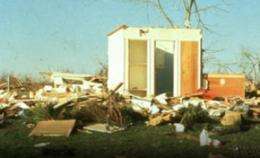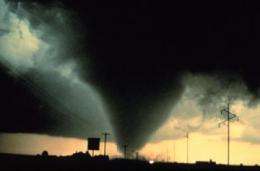A safe room? Or a new home entertainment center?

For 18 horrific hours on April 3, 1974, the largest and most cataclysmic tornado on record for a single 24-hour period took North America by storm. Actually, it was 148 tornadoes, which spun through and sacked 13 states and one Canadian province, ravaging some 900 square miles and killing 148 people.
An iconic photo snapped in the tragedy's aftermath speaks the proverbial thousand words: amid a landscape devastated, and houses crushed like eggshells, one thing remained intact, standing erect and defying nature's wrath: an interior bathroom of a single house, whose walls had not been connected to the rest of the house. The photo demonstrated how a single room can withstand the wrath of a tornado and serve as a safe haven.
Today, a consortium of government officials and academics works to raise awareness about the life-saving capabilities of storm shelters.
The team is a who's who of researchers and atmospheric scientists and includes the Department of Homeland Security Science and Technology Directorate (S&T); the Federal Emergency Management Agency (FEMA); the Southeast Region Research Initiative (SERRI); the Walt Disney World Resort; the International Code Council (ICC); the Federal Alliance for Safe Homes; and the Oak Ridge National Lab.
Their focus is a pilot project called the Resilient Home Program, which is funded in part by S&T's Infrastructure and Geophysical Division. The program incorporates newly revised guidance from FEMA on designs for basement, in-ground, and above-ground safe rooms; and an ICC standard, which specifies requirements for the design and construction of such sanctuaries.
The program takes place in the American Southeast, a region that draws tornadoes with a frequency and fury that rival the famous "tornado alley" of the Midwest. Making matters worse, the Southeast is a magnet for nocturnal storms, which strike between sunset and sunrise and often double the fatalities of their daytime counterparts. Furthermore, the Southeast's population is particularly vulnerable to disasters, with large numbers of seniors and mobile homes.
Last year, tornadoes pummeled homes and farms in 18 FEMA-declared disasters, stretching from Florida, through the South, and up into Illinois. So far this year, tornadoes have been a part of six more disasters, most recently in Oklahoma and Mississippi. On May 10, 2010, at least 22 tornadoes tore through the Sooner State on a single day, ripping off metal roofs and killing several. In the Magnolia State, an unusually high number of homes in the storm's path—more than half—were destroyed on April 24. Each flattened wooden frame left behind a reminder about the need for a pocket of space that can turn back a howling twister.
And the tornado season is far from over.

"The Resilient Home Program isn't a 30-page report that winds up in a binder on a bookshelf," says S&T program manager Mike Matthews. "It's a roll-up-your-sleeves collaboration among many different entities — homeowners, builders, and insurers — that will help to fortify people's homes, lives and communities."
As Matthews sees it, the sooner families can return to their homes, the faster a community can recapture its vitality.
The team is undertaking a two-part process. First, the research: Why do some homeowners opt for safe rooms while others go without? Then the outreach: Use these findings to communicate with the public and the construction and insurance industries.
The team surveyed 822 homeowners in seven states: Alabama, Florida, Georgia, Kentucky, Mississippi, South Carolina, and Tennessee. Participants were asked a battery of questions about their knowledge of and interest in safe rooms.
"The more we understand about how people perceive safe rooms, the more success we'll have in increasing their number," says Matthews.
From their answers, certain patterns emerged. For instance, homeowners are well-aware that safe rooms can save their lives. Yet they see little value in investing in something that would be used so little or perhaps not at all. For that kind of cash (about $10,000), they'd rather buy a home theater or remodel their kitchen. So the team decided to brand safe rooms as a home-furnishing project—something fun rather than a necessary evil. After all, from bathrooms to bedrooms to boardrooms, there's a reality show on remodeling it.
The messaging was refined in March in focus groups with remodelers and builders. Further creative honing has continued in recent months via interviews with consumers and meetings with insurers to identify incentives that will defray construction costs.
In the meantime, the team is engaged in good old public relations, promoting Resilient Homes via TV segments, partnerships, speeches, workshops, demos—and outreach articles like this one.
Provided by US Department of Homeland Security

















